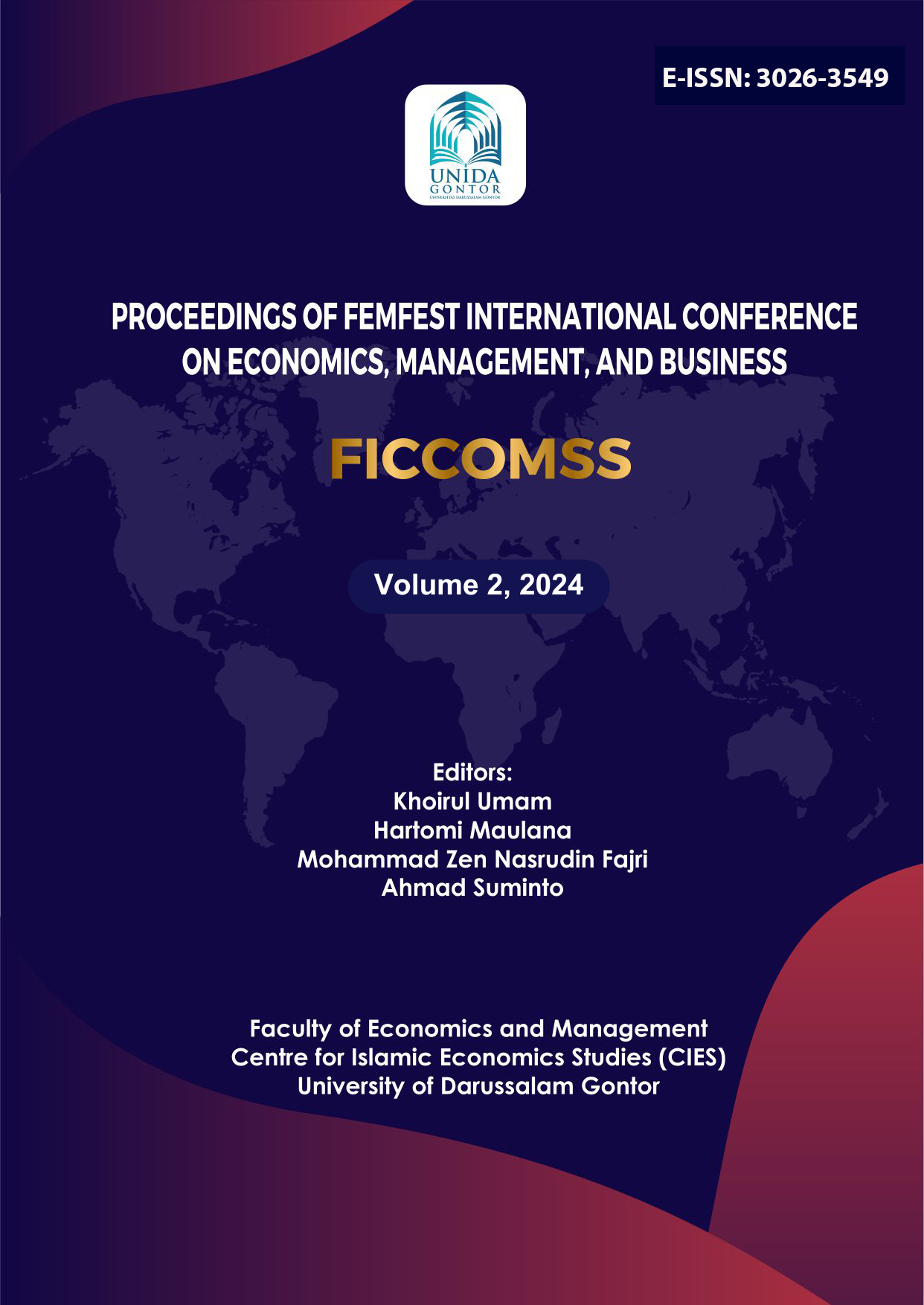The Effect of the Product, Price, Place and Promotion on the Customer Satisfaction According to the Islamic Perspective
Abstract
The marketing mix (Product, Price, Place, and Promotion) is essential in achieving buyer satisfaction, especially from the Islamic perspective. This quantitative research study aims to test the effect of the marketing mix on buyer satisfaction from an Islamic perspective, especially in the case of the La Tansa Sandal Factory. This study used multiple linear regression analysis methods and involved 200 respondents. La Tansa Sandal Factory is a business unit of Darussalam Gontor Islamic Boarding School, an Islamic educational institution that has achieved economic independence through a successful economic protection program. The results showed that the product variable (X1) had a significant positive effect on customer satisfaction (Y), while the price variable (X2) had a significant adverse impact on customer satisfaction (Y). The place variable (X3) also has a negative and insignificant effect on customer satisfaction (Y), while the promotion variable (X4) has a positive and significant impact on customer satisfaction (Y). These findings highlight the urgency of the marketing mix on buyer satisfaction, emphasizing the importance of product quality and promotional strategies in improving customer satisfaction from an Islamic perspective. La Tansa Sandals Manufacturers should focus on increasing their products' uniqueness, universality, relevance, and quality. They can research to understand the needs and preferences of their customers and develop products that meet those needs. They can also invest in product design and innovation to differentiate themselves. Keywords: Marketing Mix 4P, Customer Satisfaction, Islamic MarketingReferences
Bawono, Anton and Shina, Arya Fendha Ibn. (2018). Applied Econometrics for Islamic Economics and Business Applications with Eviews. Salatiga: LP2M IAIN Salatiga.
Bawono, Anton. (2006). Multivariable Analysis with SPSS. STAIN: Salatiga Press.
Bezos, Jeff. (2004) "12 Marketing Mix Strategies In Marketing 5.0." Marketing: 30.
Cannon, William, and Jerome. (2008) Basic Marketing Global Managerial Approach, Jakarta: Salemba Empat
Cardia, D. I. N. R., I. Wayan Santika, and Ni Nyoman Rsi Respati. (2019) "The Effect of Product Quality, Pricing, And Promotion On Customer Loyalty." E-Journal of Management 8, no. 11: 6762-6781.
Daryanto, Sari Kuliah Manajemen Marketing, (Bandung: PT. Means of Prosperous Conscience Tutorial, 2011)
Djodjobo, Cynthia Vanessa, and Hendra N. Tawas. "The influence of entrepreneurial orientation, product innovation, and competitive advantage on the marketing performance of the yellow rice business in Manado city." EMBA Journal: Journal of Economic, Management, Business, and Accounting Research 2.3 (2014).
Garaika, Garaika, and Winda Feriyan. "Promotion and its effect on the interest of prospective new students in choosing private universities." ACTUAL Journal 16, no. 1 (2019): 21-27.
Ghozali, Imam. 2013. Applications of Multivariate Analysis with IBM SPSS 23 Programs. Semarang: BAdam Diponegoro University Publishers. Pg 96.
Gujarati, Damodar. (2007). Fundamentals of Econometrics. Jakarta: Erlangga
Gunawan, R. P., & Ratmono, R. (2022). The Effect of Price, Promotion, Service Quality, and Product Design on the Purchasing Decision of Honda Beat Motorcycles on CV Istana Motor Bandar Jaya. Journal of DIVERSIFICATION Management, 2(1), 190-198.
Hendri, Ma'ruf. (2005). Retail Marketing. Jakarta: PT Gramedia Pustaka Utama.
Hidayah, Ida, Teguh Ariefiantoro, Dwi Widi Pratito Sri Nugroho, and Edy Suryawardana. "Analysis of Marketing Mix Strategy in Increasing Sales Volume (Case Study on Pudanis in Kaliwungu)." Solution 19, no. 1 (2021).
Janie, Dyah Nirmala. (2012). Descriptive Statistics and Multiple Linear Regression with SPSS. Semarang: Semarang University Press.
Kasiram, Moh. 2008. Research Methodology. Malang: UIN-Malang Press. Pg 257
Lestari, Warni, Sitti Musyahidah, and Rabaniah Istiqamah. "Marketing Mix Strategy in Improving Printing Business on CV. Kaili Ink in Islamic Economic Perspectives." Journal of Islamic Economics and Business 1, no. 1 (2019): 63-84.
Moh. Prabundu Tika, Business Research Methodology, (Jakarta: Bumi Aksara, 2006), 60.
Nauka, Moh. "The concept of the marketing mix in an Islamic perspective." BISEI: Journal of Islamic Business and Economics 5, no. 01 (2020): 31.
Nasution, Muhammad Fakhru Rizky. "The effect of promotions and prices on the interest in buying housing obama PT. Nailah Adi Kurnia SEI Mencirim Medan." Scientific Journal of Management and Business 14, no. 2 (2014).
Philip Kotler, Marketing Management Asian Perspective, (Yogyakarta: CV. Andi, 2003).
Rachmawati, Rina. "The role of the marketing mix on increasing sales (a study of the restaurant business)." Journal of Engineering Competence 2.2 (2011).
Riduwan, Methods and Techniques for Compiling a Thesis,.....,p.86.
Riduwan, The Scale of Measurement of Research Variables, Bandung: Alfbeta, 2011, p. 25- 27.
Rohaeni, Heni, and Nisa Marwa. "Quality of Service To Customer Satisfaction." Journal of Ecodemica 2, no. 2 (2018): 314.
Samad, Abdul, and Imam Wibowo. "Product Influence and Brand Image on Specs Brand Sports Shoe Purchasing Decision in Bekasi City." Krisnadwipayana Journal of Business Management 4, no. 3 (2016): 1-9.
Siregar, Your Majesty. "Customer Satisfaction Analysis of Ompu Gende Coffee Medan." Journal of Diversita 7, no. 1 (2021): 115.
Suharsimi Arikunto, Research Procedures: A Practical Approach, Jakarta: PT Rineka Cipta, 2002, pp. 206.
Winarno, Wing Revelation, 2006. Accounting Information Systems. Yogyakarta: UPP STIM YKPN Yogyakarta.






